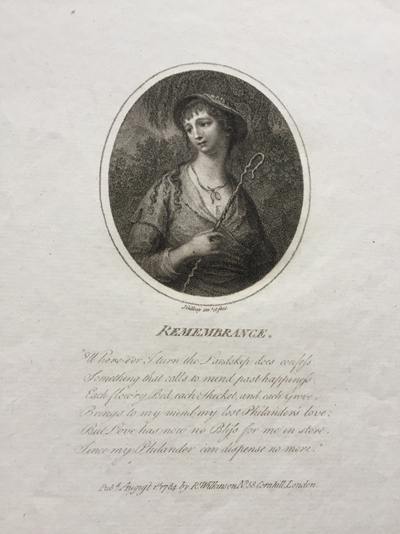Remembrance
This is one of a set of paired prints, Absence and Remembrance both published on the same day (August 1st, 1784) by the same publisher Robert Wilkinson. Gillray had established a business relationship with Wilkinson at least as early as 1781 when Gillray copied and etched a portrait of Hyder Ally, the Sultan of Mysore. And it was Wilkinson who thereafter published nearly all of Gillray's "serious" prints.
Absence features a single figure portrait bust of a country swain looking mournfully to his left. Remembrance features a corresponding single figure portrait bust of a sorrowful shepherdess (a tear running down her cheek) facing right. The prints were almost certainly designed to hang on the same wall, like husband and wife portraits, gazing at one another. And they should be treated as a unit. For some reflections on the pastoral tradition to which these paired prints belong, see my commentary on Absence.

© Benjamin Lemer, Private Collection
Unlike the accompanying text for Absence, there is no attribution provided for the caption of Remembrance
Where-e'er I turn the Landskip does confess
Something that calls to mind past happiness,
Each flow'ry Bed, each thicket, & each grove
Brings to my mind my lost Philander's love
But Love has now no Bliss for me in store
Since my Philander can dispense no more.
But it is almost certain that the lines are derived from a poem by Aphra Behn called "The Prospect and Bower of Bliss,"which Gillray could have found in an edition of Behn's Poems published in 1683 or in a collection of verses by women called Poems by Eminent Ladies. . . published in 1755.
Here are the lines from Aphra Behn..
From the inchanting bower I madly fly,
That bower that now no more affords me joy.
Love had not left for me one bliss in store
Since my Aminta cou'd dispense no more
____Thence to a silent Desart I advance,
And call'd the Desart of Remembrance'
. . .
Each bank, each bow'r, each dear inviting shade,
That to our sacred loves was conscious made.
Each flow'ry bed, each thicket, and each grove,
Where I have lain charm'd with Aminta's love;
(Where e'er) she cheer'd the day, and bless'd the night)
Eternally are present to my sight.
Where e'er I turn, the landskip does confess,
Something that calls to mind past happiness.
Though selections have been made, the order of the lines rearranged, and the sex of the love object changed from Aminta to Philander, it is clear that all the lines in the Gillray caption derive from Behn. And one could even argue that Gillray's title was suggested by the lines about "the Desart of Remembrance." Why then did Gillray acknowledge Pope, but not Behn?
He may have thought that in changing and rearranging the lines, he had done enough to make them his own. Or that Behn was simply not famous enough to bring her own cachet to Gillray's project. But I suspect that, on the contrary, Behn was too well-known as the writer of sometimes scandalous plays and poems. Fairly or unfairly, the mention of Behn or her pen name Astrea would have called forth the wrong associations. Pope, for instance, famously described Behn in some lines from his Imitations of Horace:
The stage how loosely does Astrea tread,
Who fairly puts all characters to bed!
This is not the sort of "remembrance" Gillray wants to call up in a sentimental pastoral print.
Sources and Reading
- Commentary from the British Museum on Remembrance.
- "Robert Wilkinson (cartographer)" Wikipedia
- "Pastoral," Wikipedia
- "Aphra Behn," Wikipedia
- "The Prospect and Bower of Bliss," ll. 2172-89 The Works of Aphra Behn V. 1 Poetry
Comments & Corrections
NOTE: Comments and/or corrections are always appreciated. To make that easier, I have included a form below that you can use. I promise never to share any of the info provided without your express permission.